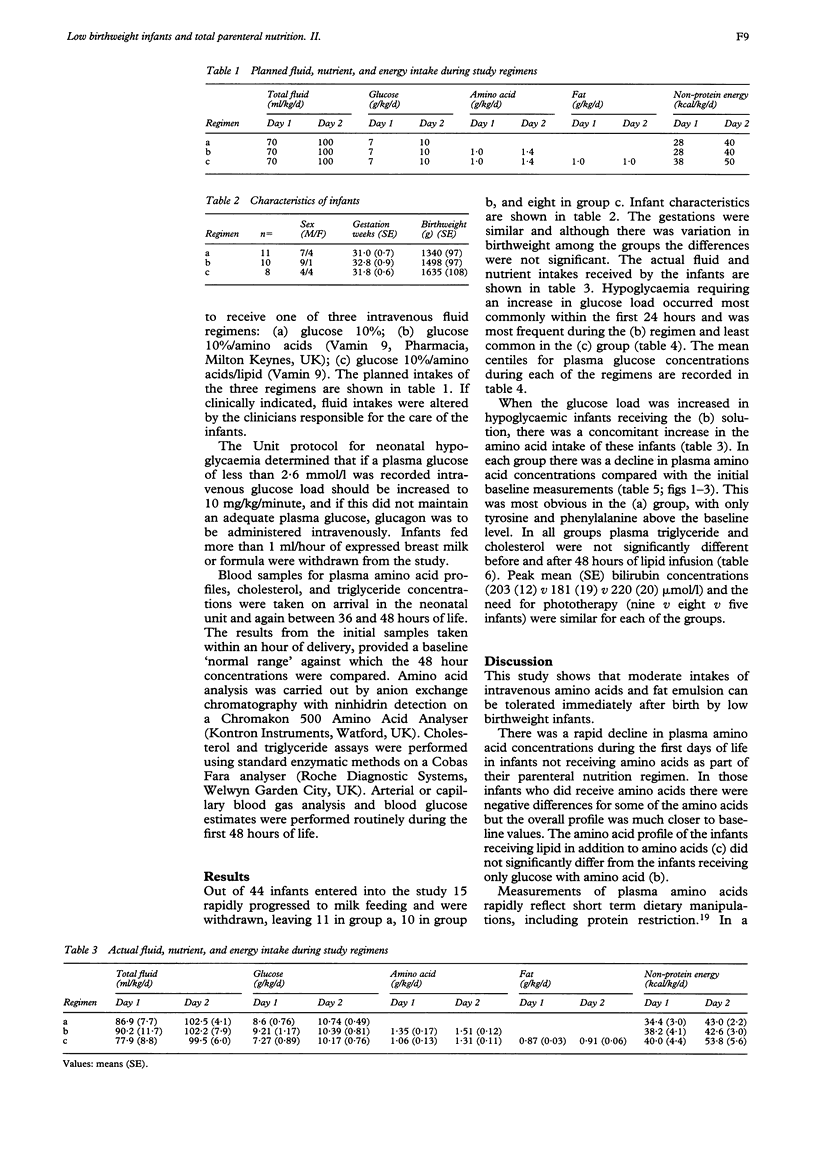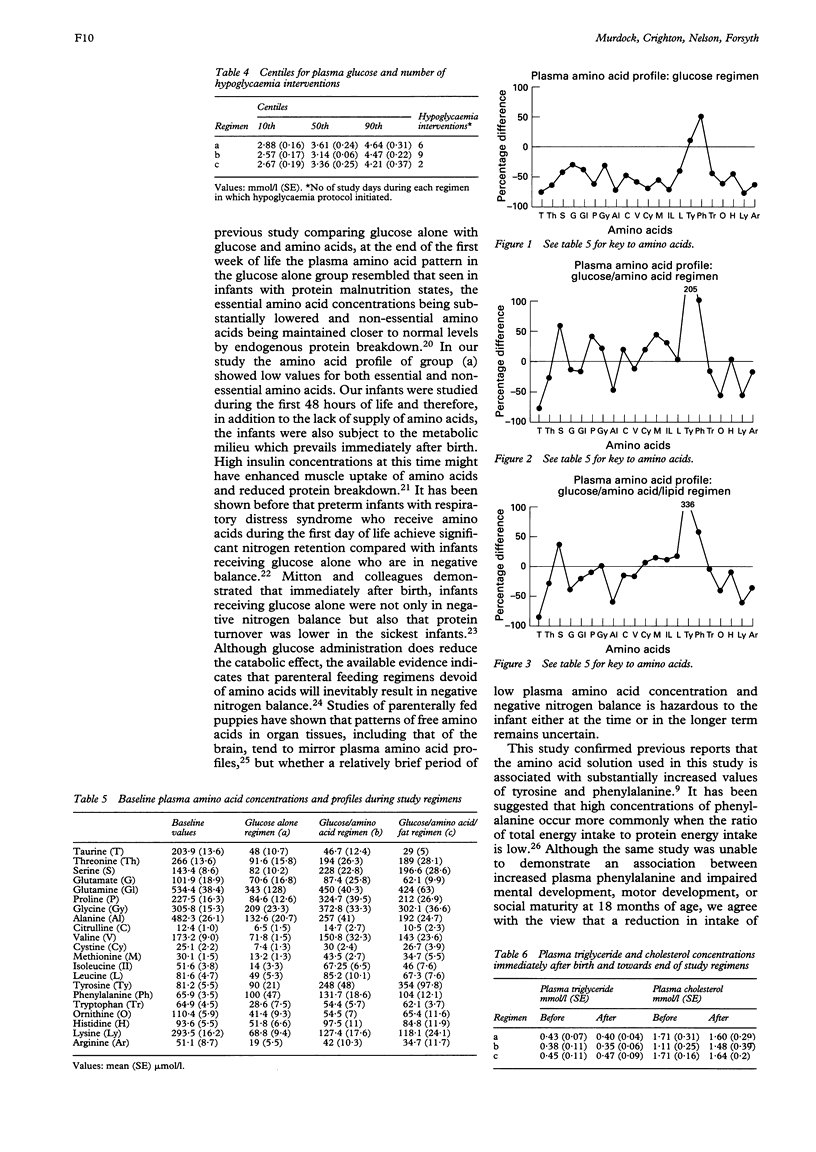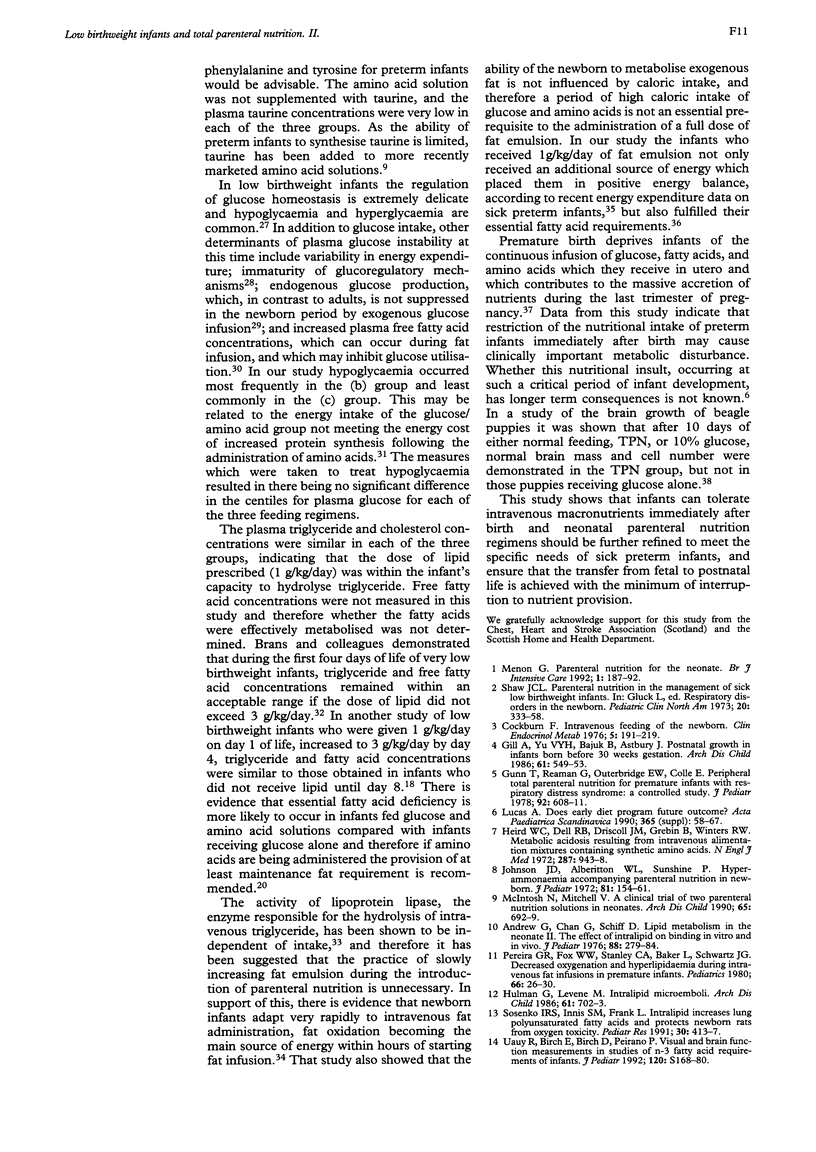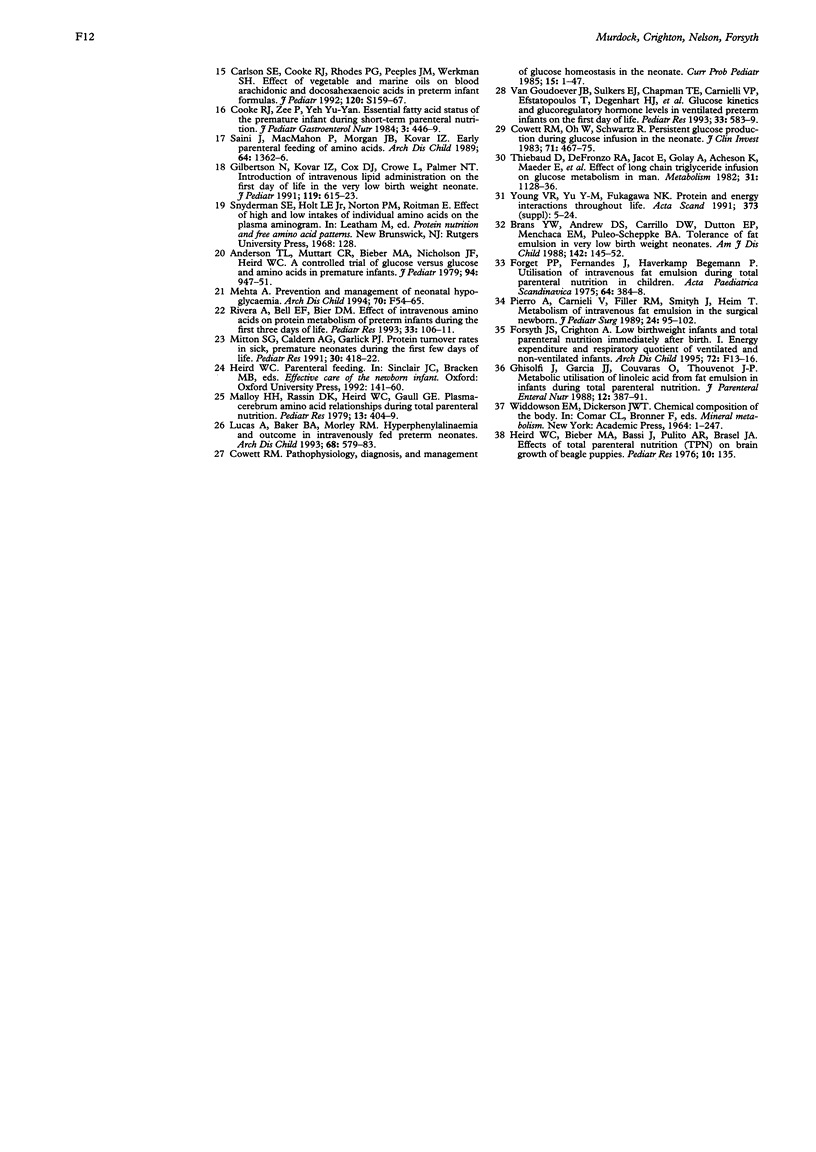Abstract
This randomised study aimed to compare the biochemical tolerance of three parenteral regimens administered during the first 48 hours of life. Twenty nine infants were randomised to either: (a) glucose 10%; (b) glucose 10%/amino acids; (c) glucose 10%/amino acids/lipid. Blood samples for plasma amino acid profiles, cholesterol, and triglyceride concentrations were taken on arrival in the neonatal unit and again between 36 and 48 hours of life. Arterial or capillary blood gas analysis and blood glucose estimates were performed routinely during the first 48 hours of life. There was a sharp decline in plasma amino acid concentrations in the group following (a) compared with the two groups following (b) and (c) regimens. In all groups plasma triglyceride and cholesterol were not significantly different before and after 48 hours of lipid infusion. Peak mean (SE) bilirubin concentrations (203 (12) v 181 (19) v 220 (20) mumol/l) and the need for phototherapy (nine v eight v five infants) were similar for each of the groups. Hypoglycaemia occurred most frequently during the (b) regimen and least commonly in the (c) group. There are potential health gains from giving parenteral nutrition to low birthweight infants immediately after birth, and this study indicates that restriction of nutritional intake immediately after birth in preterm infants may cause significant metabolic disturbance. This can be prevented by starting a regimen of intravenous amino acids and lipid immediately after birth.
Full text
PDF




Selected References
These references are in PubMed. This may not be the complete list of references from this article.
- Anderson T. L., Muttart C. R., Bieber M. A., Nicholson J. F., Heird W. C. A controlled trial of glucose versus glucose and amino acids in premature infants. J Pediatr. 1979 Jun;94(6):947–951. doi: 10.1016/s0022-3476(79)80230-9. [DOI] [PubMed] [Google Scholar]
- Andrew G., Chan G., Schiff D. Lipid metabolism in the neonate. II. The effect of Intralipid on bilirubin binding in vitro and in vivo. J Pediatr. 1976 Feb;88(2):279–284. [PubMed] [Google Scholar]
- Brans Y. W., Andrew D. S., Carrillo D. W., Dutton E. P., Menchaca E. M., Puleo-Scheppke B. A. Tolerance of fat emulsions in very-low-birth-weight neonates. Am J Dis Child. 1988 Feb;142(2):145–152. doi: 10.1001/archpedi.1988.02150020047024. [DOI] [PubMed] [Google Scholar]
- Cockburn F. Intravenous feeding of the newborn. Clin Endocrinol Metab. 1976 Mar;5(1):191–219. doi: 10.1016/s0300-595x(76)80014-x. [DOI] [PubMed] [Google Scholar]
- Cooke R. J., Zee P., Yeh Y. Y. Essential fatty acid status of the premature infant during short-term fat-free parenteral nutrition. J Pediatr Gastroenterol Nutr. 1984 Jun;3(3):446–449. doi: 10.1097/00005176-198406000-00024. [DOI] [PubMed] [Google Scholar]
- Cowett R. M., Oh W., Schwartz R. Persistent glucose production during glucose infusion in the neonate. J Clin Invest. 1983 Mar;71(3):467–475. doi: 10.1172/JCI110791. [DOI] [PMC free article] [PubMed] [Google Scholar]
- Cowett R. M. Pathophysiology, diagnosis, and management of glucose homeostasis in the neonate. Curr Probl Pediatr. 1985 Mar;15(3):1–47. doi: 10.1016/0045-9380(85)90059-3. [DOI] [PubMed] [Google Scholar]
- Forget P. P., Fernandes J., Begemann P. H. Utilization of fat emulsion during total parenteral nutrition in children. Acta Paediatr Scand. 1975 May;64(3):377–384. doi: 10.1111/j.1651-2227.1975.tb03851.x. [DOI] [PubMed] [Google Scholar]
- Ghisolfi J., Garcia J., Couvaras O., Thouvenot J. P., Olives J. P. Metabolic utilization of linoleic acid from fat emulsion in infants during total parenteral nutrition. JPEN J Parenter Enteral Nutr. 1988 Jul-Aug;12(4):387–391. doi: 10.1177/0148607188012004387. [DOI] [PubMed] [Google Scholar]
- Gilbertson N., Kovar I. Z., Cox D. J., Crowe L., Palmer N. T. Introduction of intravenous lipid administration on the first day of life in the very low birth weight neonate. J Pediatr. 1991 Oct;119(4):615–623. doi: 10.1016/s0022-3476(05)82416-3. [DOI] [PubMed] [Google Scholar]
- Gill A., Yu V. Y., Bajuk B., Astbury J. Postnatal growth in infants born before 30 weeks' gestation. Arch Dis Child. 1986 Jun;61(6):549–553. doi: 10.1136/adc.61.6.549. [DOI] [PMC free article] [PubMed] [Google Scholar]
- Gunn T., Reaman G., Outerbridge E. W., Colle E. Peripheral total parenteral nutrition for premature infants with the respiratory distress syndrome: a controlled study. J Pediatr. 1978 Apr;92(4):608–613. doi: 10.1016/s0022-3476(78)80304-7. [DOI] [PubMed] [Google Scholar]
- Heird W. C., Dell R. B., Driscoll J. M., Jr, Grebin B., Winters R. W. Metabolic acidosis resulting from intravenous alimentation mixtures containing synthetic amino acids. N Engl J Med. 1972 Nov 9;287(19):943–948. doi: 10.1056/NEJM197211092871901. [DOI] [PubMed] [Google Scholar]
- Hulman G., Levene M. Intralipid microemboli. Arch Dis Child. 1986 Jul;61(7):702–703. doi: 10.1136/adc.61.7.702. [DOI] [PMC free article] [PubMed] [Google Scholar]
- Johnson J. D., Albritton W. L., Sunshine P. Hyperammonemia accompanying parenteral nutrition in newborn infants. J Pediatr. 1972 Jul;81(1):154–161. doi: 10.1016/s0022-3476(72)80395-0. [DOI] [PubMed] [Google Scholar]
- Lucas A., Baker B. A., Morley R. M. Hyperphenylalaninaemia and outcome in intravenously fed preterm neonates. Arch Dis Child. 1993 May;68(5 Spec No):579–583. doi: 10.1136/adc.68.5_spec_no.579. [DOI] [PMC free article] [PubMed] [Google Scholar]
- Lucas A. Does early diet program future outcome? Acta Paediatr Scand Suppl. 1990;365:58–67. doi: 10.1111/j.1651-2227.1990.tb11584.x. [DOI] [PubMed] [Google Scholar]
- McIntosh N., Mitchell V. A clinical trial of two parenteral nutrition solutions in neonates. Arch Dis Child. 1990 Jul;65(7 Spec No):692–699. doi: 10.1136/adc.65.7_spec_no.692. [DOI] [PMC free article] [PubMed] [Google Scholar]
- Mehta A. Prevention and management of neonatal hypoglycaemia. Arch Dis Child Fetal Neonatal Ed. 1994 Jan;70(1):F54–F60. doi: 10.1136/fn.70.1.f54. [DOI] [PMC free article] [PubMed] [Google Scholar]
- Mitton S. G., Calder A. G., Garlick P. J. Protein turnover rates in sick, premature neonates during the first few days of life. Pediatr Res. 1991 Nov;30(5):418–422. doi: 10.1203/00006450-199111000-00005. [DOI] [PubMed] [Google Scholar]
- Periera G. R., Fox W. W., Stanley C. A., Baker L., Schwartz J. G. Decreased oxygenation and hyperlipemia during intravenous fat infusions in premature infants. Pediatrics. 1980 Jul;66(1):26–30. [PubMed] [Google Scholar]
- Pierro A., Carnielli V., Filler R. M., Smith J., Heim T. Metabolism of intravenous fat emulsion in the surgical newborn. J Pediatr Surg. 1989 Jan;24(1):95–102. doi: 10.1016/s0022-3468(89)80310-0. [DOI] [PubMed] [Google Scholar]
- Rivera A., Jr, Bell E. F., Bier D. M. Effect of intravenous amino acids on protein metabolism of preterm infants during the first three days of life. Pediatr Res. 1993 Feb;33(2):106–111. doi: 10.1203/00006450-199302000-00003. [DOI] [PubMed] [Google Scholar]
- Saini J., MacMahon P., Morgan J. B., Kovar I. Z. Early parenteral feeding of amino acids. Arch Dis Child. 1989 Oct;64(10 Spec No):1362–1366. doi: 10.1136/adc.64.10_spec_no.1362. [DOI] [PMC free article] [PubMed] [Google Scholar]
- Sosenko I. R., Innis S. M., Frank L. Intralipid increases lung polyunsaturated fatty acids and protects newborn rats from oxygen toxicity. Pediatr Res. 1991 Nov;30(5):413–417. doi: 10.1203/00006450-199111000-00004. [DOI] [PubMed] [Google Scholar]
- Thiébaud D., DeFronzo R. A., Jacot E., Golay A., Acheson K., Maeder E., Jéquier E., Felber J. P. Effect of long chain triglyceride infusion on glucose metabolism in man. Metabolism. 1982 Nov;31(11):1128–1136. doi: 10.1016/0026-0495(82)90163-9. [DOI] [PubMed] [Google Scholar]
- Young V. R., Yu Y. M., Fukagawa N. K. Protein and energy interactions throughout life. Metabolic basis and nutritional implications. Acta Paediatr Scand Suppl. 1991;373:5–24. doi: 10.1111/j.1651-2227.1991.tb18147.x. [DOI] [PubMed] [Google Scholar]
- van Goudoever J. B., Sulkers E. J., Chapman T. E., Carnielli V. P., Efstatopoulos T., Degenhart H. J., Sauer P. J. Glucose kinetics and glucoregulatory hormone levels in ventilated preterm infants on the first day of life. Pediatr Res. 1993 Jun;33(6):583–589. doi: 10.1203/00006450-199306000-00010. [DOI] [PubMed] [Google Scholar]


